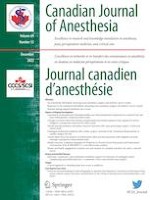Erschienen in:

05.10.2022 | Reports of Original Investigations
Airway injury from the presence of endotracheal tubes and the association with subglottic secretion drainage: a prospective observational study
verfasst von:
Stephanie R. Sibley, MD, SM, FRCPC, Ian M. Ball, MD, MSc, FRCPC, Christine L. D’Arsigny, MD, FRCPC, FCCP, John W. Drover, MD, FRCSC, CCPE, Jason W. Erb, MD, FRCPC, Imelda M. Galvin, MB, BaO, BcH, MRCPCH, FRCA, MSc, Daniel W. Howes, MD, FRCPC, Roy Ilan, MD, MSc, FRCPC, David W. Messenger, MD, MM, FRCPC, FCCP, Susan L. Moffatt, MD, FRCPC, Christopher M. Parker, MD, MSc, FRCPC, FCCP, Stacy Ridi, MD, FRCPC, John Muscedere, MD, FRCPC
Erschienen in:
Canadian Journal of Anesthesia/Journal canadien d'anesthésie
|
Ausgabe 12/2022
Einloggen, um Zugang zu erhalten
Abstract
Purpose
Laryngeal and tracheal injuries are known complications of endotracheal intubation. Endotracheal tubes (ETTs) with subglottic suction devices (SSDs) are commonly used in the critical care setting. There is concern that herniation of tissue into the suction port of these devices may lead to tracheal injury resulting in serious clinical consequences such as tracheal stenosis. We aimed to describe the type and location of tracheal injuries seen in intubated critically ill patients and assess injuries at the suction port as well as in-hospital complications associated with those injuries.
Methods
We conducted a prospective observational study of 57 critically ill patients admitted to a level 3 intensive care unit who were endotracheally intubated and underwent percutaneous tracheostomy. Investigators performed bronchoscopy and photographic evaluation of the airway during the percutaneous tracheostomy procedure to evaluate tracheal and laryngeal injury.
Results
Forty-one (72%) patients intubated with ETT with SSD and sixteen (28%) patients with standard ETT were included in the study. Forty-seven (83%) patients had a documented airway injury ranging from hyperemia to deep ulceration of the mucosa. A common tracheal injury was at the site of the tracheal cuff. Injury at the site of the subglottic suction device was seen in 5/41 (12%) patients. There were no in-hospital complications.
Conclusions
Airway injury was common in critically ill patients following endotracheal intubation, and tracheal injury commonly occurred at the site of the endotracheal cuff. Injury occurred at the site of the subglottic suction port in some patients although the clinical consequences of these injuries remain unclear.











